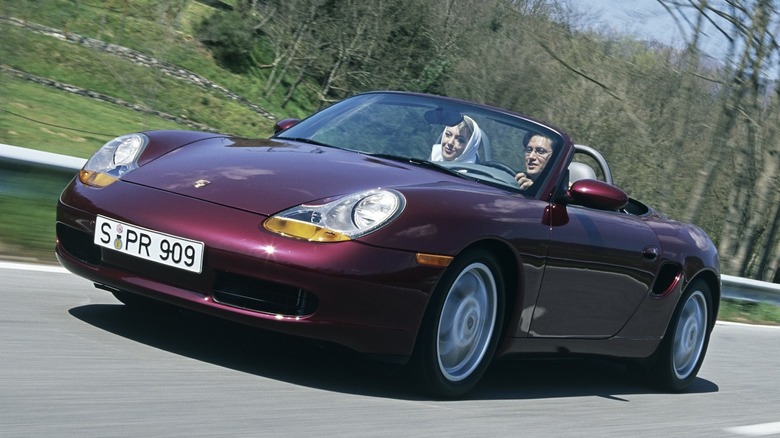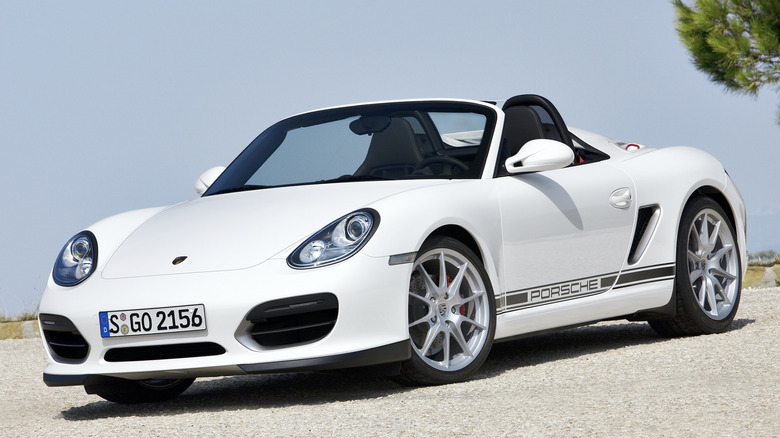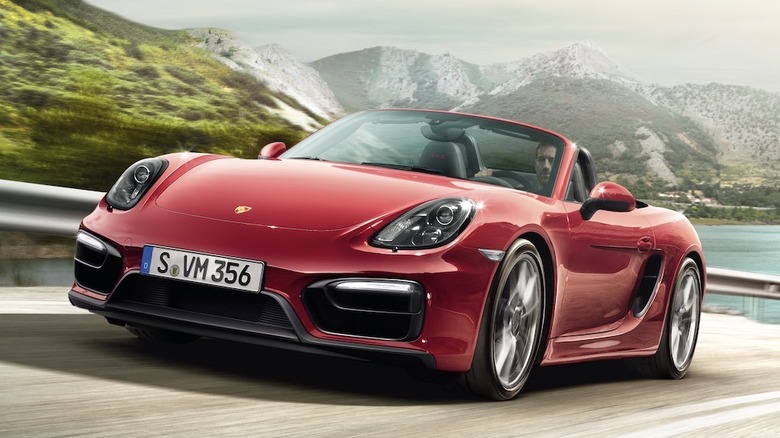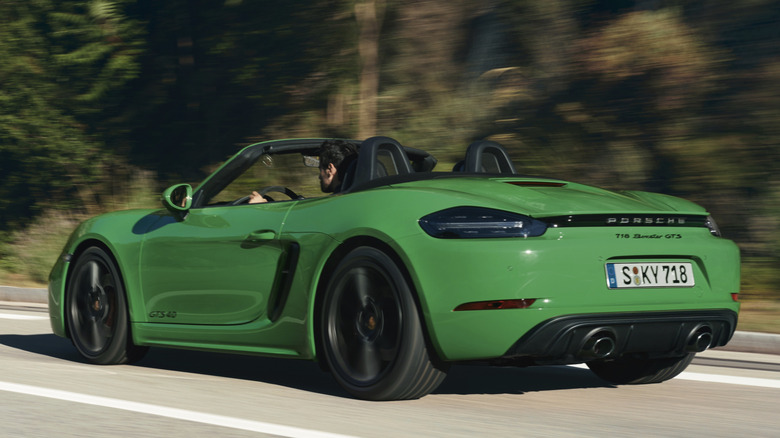Which Model Saved Porsche From Bankruptcy In The '90s?
It was a little over 30 years ago — Porsche was in a world of hurt as the early 1990s delivered a triple whammy of an inefficient production processes, poor car sales, and an economic recession in the U.S. Porsche needed a magic bullet to turn things around.
Inspired by Mazda's success with the MX-5 Miata starting in 1989, Porsche saw the potential for an affordable mid-engine sports car that could both draw on the company's heritage and sell in decent numbers. It would be a replacement for the previous platform that had spawned the 924, the 944, and the 968. The new car, known as type 986, would be the successor to the renowned Porsche 550 Spyder that made its racing bones back in the 1950s. As Mazda had proven, the world's markets were ready for to buy roadsters. This one would have the Porsche name on it and be named the Boxster.
The only problem remaining was that Porsche was in no condition to produce a mass-market vehicle in quantity. Its production process was antiquated, requiring extensive searches through parts bins for the components required to make each individual vehicle. It was taking Porsche 120 hours to make a single car, which was way too long to make them profitably. A change was needed, and it was needed fast.
Toyota's just-in-time production system to the rescue
It was 1992 when Porsche CEO Wendelin Wiedeking brought in some former Toyota engineers who were familiar with Toyota's famed "just-in-time" production system. The Toyota process organizes the ordering of parts to eliminate waste in the production system. Everything that is needed to make the cars going down the assembly line is available for the production workers as they need it, while anything else is simply not necessary to have on hand.
The results of this process change were immediate — the hours required to build a car came down to 72 hours, with a 50% reduction in the number of problems per car that needed to be fixed. Porsche had finally fixed its production process and was competitive within the industry as far as profitability was concerned.
But the changes that were made to make both Boxster and 911 production more efficient created some friction within the enthusiast community. There was significant push-back against the striking similarities between these two Porsche vehicles.
Why were the Boxster and 911 so similar back then?
Pursuing a more efficient production process in the wake of its learnings about the Toyota production system, Porsche engineers introduced some parts commonality between the 986 Boxster and the type 996 platform of the upcoming 911, both of which were water-cooled. One main benefit of this part-sharing arrangement would be reduced per-part prices due to larger quantities being ordered. This was a key way to help build profitability into the production of both vehicles.
The most noticeable item shared by both vehicles was the "fried-egg headlights," which combined the headlights, parking lights, and turn signals into one large unit. This no doubt reduced assembly time on the production line, but it was a major styling change compared to the previously separated headlights and ancillary front lighting. Many 911 fans were not very happy. The Porsche 996 became one of the cheapest Porsches you could buy as a result. Even though there was some part-sharing, the Boxster still had its own unique instrument panel, front fascia, and smaller windshield.
The Boxster saved Porsche from bankruptcy in the '90s
The Boxster was a very successful entry-level model for Porsche at the beginning of the water-cooled era, with frequent upgrades to keep it fresh. During the period from 1996 to 2003, the Boxster held the spot as Porsche's top-selling model, keeping the company afloat. Porsche's final step to ongoing high profitability was the 2002 start of production of the Cayenne SUV for the 2003 model year, supplemented in model year 2015 by the smaller Macan SUV. The Macan, as Porsche's entry-level SUV, has become Porsche's top-selling vehicle in the U.S., selling 26,947 copies out of a total of 75,415 Porsche sales in calendar 2023.
The future of the Boxster (and its coupe version, the Cayman, introduced for the 2006 model year) is somewhat uncertain going forward. Porsche originally announced that the Boxster and Cayman would become electric vehicles (EVs), with the internal combustion engine (ICE) versions being discontinued during the 2025 model year. But in the face of slowing EV sales around the world, Porsche is rethinking its strategy. It will refocus on ICE engines and hybrids in addition to its EV efforts. This could either lead to the ICE versions of the Boxster and Cayman staying around a few years longer, or the refitting of the EV versions for ICE or hybrid powertrains.



